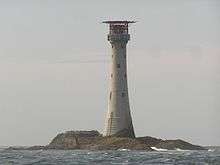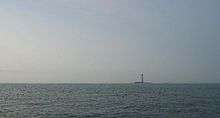Smalls Lighthouse
 Smalls Lighthouse in 2009 | |
 United Kingdom | |
| Location |
The Smalls off Marloes Peninsula Pembrokeshire Wales |
|---|---|
| Coordinates | 51°43′16″N 5°40′11″W / 51.721239°N 5.669831°WCoordinates: 51°43′16″N 5°40′11″W / 51.721239°N 5.669831°W |
| Year first constructed | 1776 (first) |
| Year first lit | 1861 (current) |
| Automated | 1987 |
| Construction | stone tower |
| Tower shape | tapered cylindrical tower with balcony, lantern and helipad on the top |
| Markings / pattern | unpainted tower |
| Height | 41 metres (135 ft) |
| Focal height | 36 metres (118 ft) |
| Current lens | 1st Order catadioptric |
| Light source | solar power |
| Intensity | 39,800 candela |
| Range | 18 nautical miles (33 km; 21 mi) |
| Characteristic | Fl (3) W 15s. (24h) |
| Admiralty number | A5278 |
| NGA number | 5600 |
| ARLHS number | WAL-023 |
| Managing agent |
Trinity House[1] [2] |
| Heritage |
Grade II listed building |
Smalls Lighthouse stands on the largest of a group of wave-washed basalt and dolerite rocks[3][4] known as The Smalls approximately 20 miles (32 km) west of Marloes Peninsula in Pembrokeshire, Wales, and 8 miles (13 km) west of Grassholm. It was erected in 1861 by engineer James Douglass to replace a previous lighthouse which had been erected in 1776[5] on the same rock. It is the most remote lighthouse operated by Trinity House.[6]
Previous lighthouse
The original Smalls Lighthouse was erected over 1775 and 1776, on the plans of Liverpool musical instrument maker Henry Whiteside.[5] It stood on nine oak pillars, allowing the sea to pass through beneath. Although it suffered from some rocking, it stood for 80 years. During its life a significant number of extra struts were added beyond the original nine.[7] The pillar-based design has since been used successfully in many sea structures.
The old lighthouse generated some fine stories. When Whiteside visited the lighthouse in 1777, he was stranded for a month by gales which showed no sign of abating so that supplies were almost exhausted. He wrote a message to a friend in St David's placed in a bottle inside a casket with a note to the finder "We doubt not but that whoever takes this up will be so merciful as to cause it to be sent to Thomas Williams, Esq, Trelithin, near St. David's, Wales". Two days later it arrived almost outside the door of the addressee to whom it was duly delivered.[8]
More disturbingly, the old lighthouse brought about a change in lighthouse policy in 1801 after a gruesome episode. The two man team, Thomas Howell and Thomas Griffith, were known to quarrel, and so when Griffith died in a freak accident, Howell feared that he might be suspected of murder if he discarded the body into the sea.[9] As the body began to decompose, Howell built a makeshift coffin for the corpse and lashed it to an outside shelf. Stiff winds blew the box apart, though, and the body's arm fell within view of the hut's window and caused the wind to catch it in such a way that it seemed as though it was beckoning.[9] Working alone and with the decaying corpse of his former colleague outside Howell managed to keep the lamp lit.[9] When Howell was finally relieved from the lighthouse the effect the situation had had on him was said to be so extreme that some of his friends did not recognise him.[9] Until the automation of British lighthouses in the 1980s lighthouse teams were changed to rosters of three men. In 2011 (repeated 3 April 2014), the affair was the subject of a BBC radio play called "The Lighthouse" written by Alan Harris.[10]. The 2016 film The Lighthouse directed by Chris Crow is based on the incident.[11]
In 1831, the tower was assaulted by a wave of such proportions that the floor of the keepers' room was torn up and slammed against the ceiling, injuring all the keepers, one so severely that he died. However the damage was repaired and the lighthouse survived another twenty years before it was replaced.[12]
Current lighthouse

The first stone of the lighthouse tower was laid on 26th June 1857,[13] Trinity House having bought out the previous leaseholders in 1836.[14] The tower was completed in 1861.[15][16]
In 1978 a helideck was erected above the lantern and in 1987 the lighthouse was automated. It is the first wind- and solar-powered lighthouse in the UK. Although it has only a 35-watt bulb, with the aid of lenses, this can be seen up to 21 miles (34 km) away. It was the first lighthouse in the country to have a flushing toilet installed.
The lighthouse's story was presented in the 2006 BBC Television programme Coast, Series 1, episode "Bristol to Fishguard".
Captain H T Sumner
Smalls Lighthouse is important in the history of navigation. In 1837 Captain Thomas Hubbard Sumner discovered the concept of celestial position lines as he was approaching Smalls Lighthouse in thick weather; they form the basis of nearly all modern celestial navigation. They were sometimes called Sumner Lines.[17][18]
See also
References
- ↑ Smalls The Lighthouse Directory. University of North Carolina at Chapel Hill. Retrieved 2 June 2016
- ↑ Smalls Lighthouse Trinity House. Retrieved 2 June 2016
- ↑ British Geological Survey 1978 1:50,000 scale geological map sheet (England & Wales)226/227 Milford, (Keyworth, Notts)
- ↑ Ordnance Survey 1:25,000 scale Explorer map sheet OL36 South Pembrokeshire
- 1 2 Lighthouse management : the report of the Royal Commissioners on Lights, Buoys, and Beacons, 1861, examined and refuted Vol. 2. p. 101.
- ↑ Nicholson, Christopher (1995). Rock lighthouses of Britain The end of an era?. Whittles Publishing. p. 53. ISBN 1-870325-41-9.
- ↑ Nicholson, Christopher (1995). Rock lighthouses of Britain The end of an era?. Whittles Publishing. p. 60. ISBN 1-870325-41-9.
- ↑ Beaver, Patrick (1971). A History of Lighthouses. London: Peter Davies. p. 39.
- 1 2 3 4 Nicholson, Christopher (1995). Rock lighthouses of Britain The end of an era?. Whittles Publishing. pp. 58–59. ISBN 1-870325-41-9.
- ↑ Retrieved 13 Sept 2011 "The Lighthouse" at bbc.co.uk
- ↑ The Lighthouse (2016) on IMDb
- ↑ Beaver 1971, p. 40.
- ↑ "General News", The Cardiff Times, p. 7, Jan 21, 1860,
The new lighthouse on the Smalls off the entrance to Milford Haven is complete as far as the exterior is concerned, the lantern having been placed on the tower, and the workmen being now engaged in finishing the interior. A landing-wharf is being erected to the north-east, to be formed of huge blocks of granite, bolted togetherin the strongest manner possible, to resist the heavy seas. The first stone of the new tower was laid on the 26th of June, 1857, so that little more than three years have been occupied in its erection. It stands 120 feet above the rock, and is very prominent at sea.
- ↑ Nicholson, Christopher (1995). Rock lighthouses of Britain The end of an era?. Whittles Publishing. p. 61. ISBN 1-870325-41-9.
- ↑ Nicholson, Christopher (1995). Rock lighthouses of Britain The end of an era?. Whittles Publishing. p. 62. ISBN 1-870325-41-9.
- ↑ "Lancaster Gazette". 24 November 1860. p. 6.
The new lighthouse on the Smalls, at the entrance to Milford Haven, is complete as far as the exterior is concerned, the lantern having been placed on the tower, and the workmen are now engaged in finishing the interior.
- ↑ Bowditch, American Practical Navigator (1958) HO Pub No 9, p55
- ↑ "Sumner Position Line". The Oxford Companion to Ships and the Sea. Oxford University Press. 2007. Retrieved 5 February 2016.
External links
| Wikimedia Commons has media related to Smalls Lighthouse. |